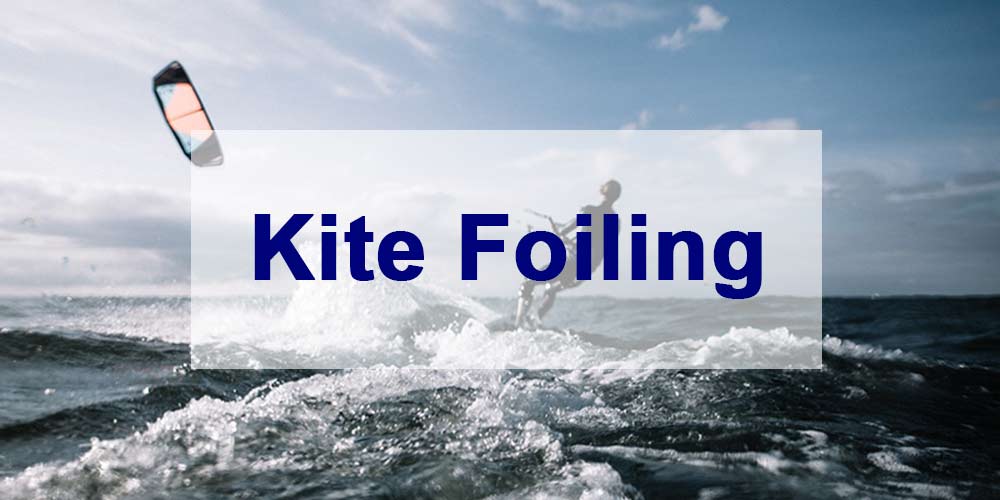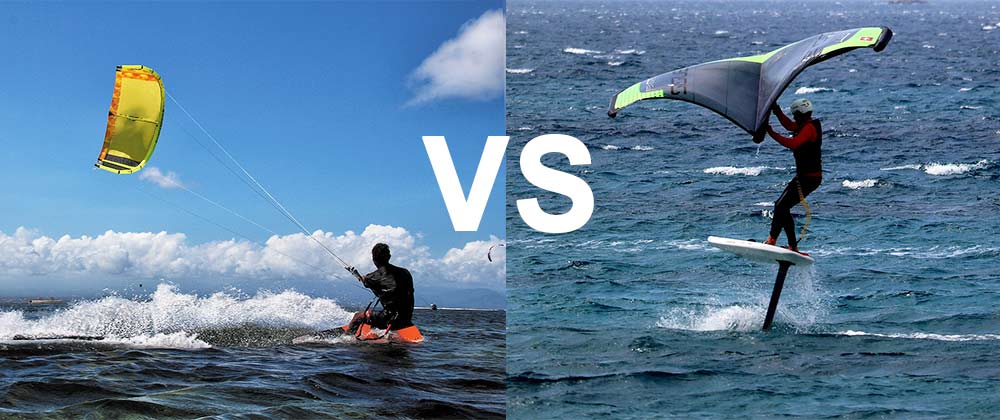Exploring the Thrills of Kite Foiling: A Detailed Guide
Kite foiling, an exhilarating and relatively recent addition to the world of water sports, seamlessly combines the art of kiteboarding with cutting-edge hydrofoil technology. This dynamic activity involves riding a specialized kiteboard equipped with a hydrofoil underneath, enabling riders to defy gravity, lift above the water's surface, and experience the sensation of gliding with remarkable fluidity.
What is Kite Foiling?
Kite foiling is a captivating water sport that deserves a closer look. Here's a comprehensive breakdown of this exciting endeavor.
The Essentials for Kite Foiling
To embark on a kite foiling adventure, you'll need the following equipment:
Kite: Kite foiling typically employs inflatable kites similar to those used in traditional kiteboarding. These kites come in various sizes to suit different wind conditions.
Kiteboard: Unlike a standard kiteboard, a kite foilboard features a special mounting system designed to attach the hydrofoil. It offers stability and precise control while gliding above the water's surface.
Hydrofoil: The heart of kite foiling, the hydrofoil consists of a mast and wings that extend below the water's surface. As the kite generates lift and propels the rider forward, the hydrofoil raises the board, reducing water resistance and delivering a smooth, gliding experience.
How Kite Foiling Operates
The process of kite foiling involves several key steps:
Launching: Kite foilers begin by inflating and launching their kite from either the beach or a boat. A control bar allows them to manage the kite's power and direction.
Riding: With the kite aloft and generating lift, the rider stands on the foilboard, gripping the control bar. As the kite exerts pull, the rider gains speed, and the hydrofoil elevates the board above the water's surface.
Balancing: Achieving balance and control is essential in kite foiling, as the board hovers above the water. Riders adjust their weight to maintain equilibrium and steer the board.
Maneuvering: Kite foilers can execute various maneuvers, including carving turns and jumps, thanks to the hydrofoil's design, which enables precise control and responsiveness.
Landing: To return to the water's surface, the rider can reduce the kite's power, allowing the board to descend gradually. Proper technique is crucial to prevent mishaps.
Benefits of Kite Foiling
Kite foiling boasts several advantages:
Efficiency: Kite foiling is remarkably efficient, enabling riders to attain high speeds even in light wind conditions.
Smooth Ride: The absence of water resistance results in an almost silent and exceptionally smooth ride, offering a one-of-a-kind experience.
Versatility: Kite foiling accommodates a wide range of water conditions, making it adaptable to diverse locations and weather patterns.
Challenges: For experienced kiteboarders seeking a fresh and exhilarating challenge, kite foiling provides a unique set of hurdles compared to traditional kiteboarding.
Kite Foiling for Beginners and Advanced Riders
Kite Hydrofoiling for Beginners:
If you're new to kite foiling, follow these steps to get started safely:
Take Lessons: Enroll in lessons with a certified instructor to learn the basics, safety protocols, and essential skills.
Master Kite Control: Prior to attempting foiling, become proficient in kite control. Spend time flying your kite on the beach or in shallow water to build confidence and control.
Start with a Large Kite: Beginners should begin with a larger kite for stability, especially in light winds. As you gain experience, transition to smaller kites for increased speed.
Choose the Right Board: Opt for a beginner-friendly kite foilboard with ample volume and stability. These boards are wider and more forgiving, facilitating the learning of balance and control.
Practice Water Starts: Learning how to water start is fundamental in kite foiling. Practice getting up on the board while keeping the foil submerged until you are comfortable with the motion.
Learn to Balance: Balancing on the foil can be challenging. Keep your weight centered over the board and adjust your stance as needed for balance. Practice is crucial.
Stay in Light Wind: Initially, practice kite foiling in light wind conditions (around 8 to 15 knots) for a forgiving experience that allows you to focus on technique.
Safety First: Always wear appropriate safety gear, including a harness, helmet, and a life jacket or personal flotation device (PFD). Be vigilant about your surroundings and potential water hazards.
For Advanced Kite Foilers:
As you progress in your kite foiling journey, consider the following tips:
Upgrade Your Gear: Invest in more specialized and high-performance equipment, such as smaller, advanced foils and boards that offer increased speed and maneuverability.
Practice Maneuvers: Once you've mastered the basics, experiment with advanced maneuvers like jibes, tacks, and jumps, which require precise control and balance.
Experiment with Different Foils: Advanced riders may want to explore various foil setups to fine-tune their experience, including different wing shapes, mast lengths, and fuselage designs.
Ride in Varied Conditions: Challenge yourself by kite foiling in various wind and water conditions, including strong winds, choppy water, and waves. Adapting to different conditions will enhance your skills.
Safety Remains Important: Regardless of your expertise, prioritize safety at all times. Continue following safety guidelines and remain aware of changing conditions on the water.
Consider Racing: Kite foiling offers competitive opportunities with foil racing events. If you're seeking an extra challenge, consider participating in local or regional kite foil races.
Kite Foiling vs. Wing Foiling
Kite foiling and wing foiling are two distinct water sports, each offering a unique experience. Here's a comparison of the two:
Kite Foiling:
Equipment: Kite foiling involves a specialized kite, a foil-equipped kiteboard, and a control bar connected to the kite lines.
Power Source: The kite generates propulsion, with riders controlling the kite's position and power to manage speed and direction.
Skills Required: Kite foiling demands proficiency in flying a kite and balancing on a foilboard, emphasizing kite control skills as the primary power source.
Riding Style: It offers a dynamic experience with the kite providing lift and speed, enabling jumps, tricks, and high-speed maneuvers.
Wind Range: Kite foiling suits a wide range of wind conditions, from light breezes to strong gusts, making it adaptable to diverse locations and wind patterns.
Learning Curve: It can be challenging for beginners due to the need for kite control skills and balancing on the hydrofoil. Lessons from a certified instructor are highly recommended.
Wing Foiling:
Equipment: Wing foiling involves a handheld wing (resembling a small windsurf sail or kite) and a foilboard. Riders hold the wing's handles and stand on the board.
Power Source: Riders use the wing to capture wind and generate propulsion, controlling speed and direction by tilting and maneuvering the wing.
Skills Required: Wing foiling demands proficiency in handling the wing and balancing on the foilboard. It places less emphasis on kite-flying skills, making it more accessible to newcomers.
Riding Style: Known for its graceful and smooth riding style, it offers a serene, nearly silent experience as riders glide above the water.
Wind Range: Wing foiling typically occurs in moderate to strong winds, requiring sufficient wind to lift the wing and propel the foilboard.
Learning Curve: While wing foiling may be more accessible to beginners in terms of kite control, it still has a learning curve, especially in terms of handling the wing and balance on the foilboard. Lessons from an instructor are advisable.
In Conclusion
Kite foiling and wing foiling are both exhilarating water sports, each offering its unique charms. The choice between the two depends on personal preferences, local wind conditions, and individual skill levels. Beginners might find wing foiling more approachable, while those with prior kiteboarding experience may gravitate toward kite foiling. In both cases, proper training and adherence to safety precautions are paramount.
If you're in need of quality surfing products, Unity Sports, a professional OEM manufacturer in the surfing industry, welcomes your inquiry without hesitation. Thank you for exploring the exciting world of kite foiling!



Comments
Post a Comment